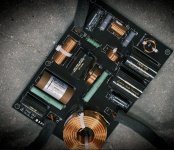Hi Jeff,
Yes, I'm impressed with their in-room bass response/performance as well. And, as I've mentioned. they are just so musically engaging that one lets go of that male audiophile "analysis paralysis" behavior that we can be susceptible to (and I'll note that women never seem to get caught up in this behavior). You just get lost in the music and presentation, and let go of all that.
As for the stands, they're resting on Pangea DS400 steel stands that are placed on a painted particle board platform. I tested a number of different platform types/materials for placing the speakers and stands onto using an iPhone app called Hamm Seismometer (what can I say? I'm a scientist, and like to measure things.

) and regular 'ole particle board damped the vibrations the best, better than tile or stone floor tiles, or MDF. It also sounded the best. I also need to fill the Pangea legs to provide more damping. Danny Ritchie recommended using sand, but that's just going to be too messy when filling them, so I'll use clay cat litter.
As for what is on top of the stands/under the speakers, the speakers are resting on four EVPs from A/V Roomservice. The EVPs are the best performing vibration dampers I've used, outperforming rubber feet, or even Herbie's Tenderfoot footers. I measured the performance of the EVPs using an iPhone app that is unfortunately no longer available called Vibsensor. You can see the data here plotted in JMP when I tested various footers under my Schiit Gungnir DAC a few years ago. I used a home-made slide hammer that dropped a socket on a bolt from a fixed height onto the rack shelf and measured the vibration imparted to the Schiit DAC. You can see in the data plot how effective the EVPs (blue trace) are compared to stock feet (green), Herbie's Tenderfoot (TF; brown), and those blue Diversitech EVA rubber vibration pads (DVT; purple), and the EVPs are the real deal. You can get them from A/V Roomservice here:
EVPs
I've not tried IsoAcoustics or Stillpoints in this experiment, so I can't speak to those.
As for other speakers, the others that come to mind are the TAD CR-1s (designed by Andrew Jones), the Evolution Acoustics MMMicroOne, and the Magico S5s, which I recently heard at Magico HQ in Hayward.
Cheers.




